Tannas Company
Modern Engine Oil Viscometry and Viscometers – Fact and Fallacy
By Ted Selby, Savant Group | TLT CMF Plus November 2013
Background
Viscosity has always been a critical property of lubricants since it is the basis of the hydrodynamic lubrication that separates lubricated surfaces moving past one another under high pressure and speed (shear rate). Thus viscosity is a major factor in reducing engine wear. On the other hand, viscosity is also a form of friction – viscous friction – and, as such, it significantly reduces the efficiency of the engine. In earlier days of automotive history, measurement of Newtonian engine oil viscosity was relatively simple since, as shown in
Figure 1; Newtonian viscosity is constant with shear rate. Viscometers were also simple at that time.
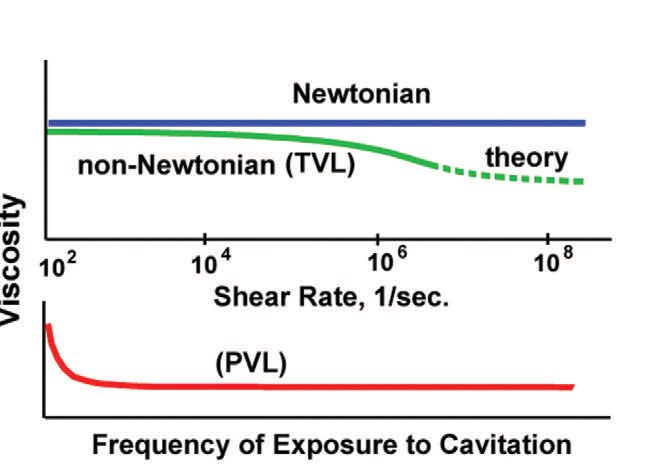 Figure 1. Rheology of Engine Oils
Multi-Grade Engine Oils
Figure 1. Rheology of Engine Oils
Multi-Grade Engine Oils
Another Perspective of Engine Oil Viscosity – After Multi-Grade oils were introduced several decades ago (to relieve the low-temperature engine starting problems of that time); they have become a favored form of engine lubricant. However, as discussed below, their complex non-Newtonian rheology accompanied by viscosity loss strongly influences formulation and viscosities of these engine oils.
As a consequence of need for meaningful measurement of the true viscosity of Multi-Grade engine oils requiring high shear rate viscometers, much development led to only two basic designs – rotational and capillary. Once such viscometers were proven and made available, high shear rate viscometry classification at 150°C became required for all engine oils carrying SAE J300 Viscosity Classification System Grades.
Multi-Grade Viscosity Loss Phenomena – Most Multi-Grade oil formulations incorporate a few percent of a selected soluble polymer which permits the engine oils to simultaneously meet SAE J300 Grades at both low and high temperatures.
Temporary Viscosity Loss (TVL) – However, not long after their introduction, it was found that the viscosities of polymer-containing, Multi-Grade oils were non-Newtonian – that is, their viscosities decreased with increasing shear rate and vice-versa as also shown in Figure 1. This behavior was called ‘temporary viscosity loss’ or TVL.
Permanent Viscosity Loss (TVL) – Moreover, it was also found that when these polymer-containing, Multi-Grade oils were subjected to cavitation (in gears or other locations in the engine); the oils were likely to permanently lose a portion of their viscosities depending on the nature of the soluble polymer. This form of viscosity loss was called ‘permanent viscosity loss’ or PVL. Again, this behavior is shown in contrast to Newtonian and non-Newtonian TVL response in
Figure 1.
Both TVL and PVL are independent of each other and have a combined viscosity effect termed Overall Viscosity Loss (OVL).
Factors Critical in High Shear Rate Viscometry
With the evident importance of viscosity in preventing engine wear, it became highly important to engine and engine oil manufacturers to develop viscometers and techniques capable of accurately and reliably measuring the viscosity of engine oils (as well as other polymer-containing lubricants) under high shear rate conditions. However, such viscometry has three highly challenging but often overlooked factors.
Confusion of PVL with TVL – One of the challenging factors was – and still is – to use viscometry which would measure TVL without inducing any PVL. Both forms of viscosity loss can occur simultaneously with any bench test procedures that, unknowingly, exert cavitation conditions in applying high shear rates.
This confusion occurred in the recent past in the published development of a claimed ultra-high shear rate viscometer in which PVL was erroneously interpreted as TVL. The error was fortunately later recognized and corrected by the authors.
Actual Shear Rate – Perhaps the most important and challenging factor is to actually know the shear rate at which the viscosity of the oil is being measured. Otherwise the viscosity determined can be in considerable error.
Rotational and Capillary Comparison – Different viscometer geometry plays a significant role in knowing the operating shear rate. It should be noted that rotational viscometry gives a single shear rate at each chosen rotor-stator gap. In contrast, in capillary viscometry the fluid passes through the capillary at multiple shear rates which simultaneously range from zero to an assumed maximum at the capillary wall.
The simultaneous multiple shear rates of capillary viscometry must be averaged to get a single shear rate by an equation that assumes the fluid’s shear rate profile across the capillary (
1) and also its shear rate value at the capillary wall. The latter information is obtained from certified non-Newtonian reference oils or from an absolute single-shear-rate rotational viscometer.
Rotational viscometry also has its challenges at high shear rates. A common error has been to assume the shear-rate-producing gap between the rotor and stator from prior measurements of the dimensions of the rotor and stator. At high shear rates at which rotor-stator clearances are very close, slight expansion or contraction of even identical rotor-stator metals can grossly distort the presumed shear rate.
Two Valid Approaches to Assuring True Shear Rate – There are two approaches to meeting the need to know the shear rate at which the rotational viscometer is operating. The first is to use an absolute rotational viscometer and the second is to use certified non-Newtonian reference oils both of which will be discussed below.
Temperature Control – A third factor, which occurs readily at higher shear rates, where viscous friction in the fluid generates considerable heat, is to closely control the chosen operating temperature of the fluid being measured. It is necessary to carefully design heat dissipation techniques.
Absolute Rotational Viscometry
The Tapered Bearing Simulator – The first commercial high shear rate rotational viscometer was, and is, called the Tapered Bearing Simulator (TBS) viscometer (
2).
Figure 2 shows a manual TBS and
Figure 3 shows a modern fully automated, shear rate maintaining, TBS viscometer.
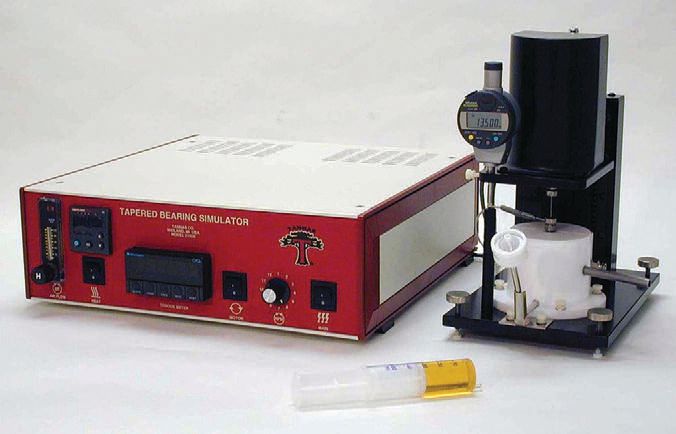 Figure 2.
Figure 2.
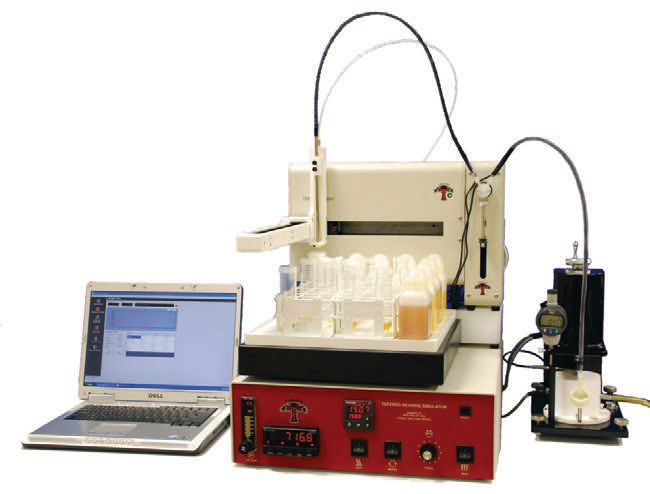 Figure 3.
Figure 3.
The TBS and Absolute High Shear Viscometry – The TBS is unique in being an absolute high shear rate viscometer (
3). As a consequence, it is capable
during operation of determining and maintaining the exact shear rate desired by the operator. To accomplish this, a version of Newton’s equation is used in which the reciprocal of shear stress is proportional to the gap between the rotor and stator.
This equation and the fact that the TBS viscometer’s rotor-stator gap is smoothly adjustable to whatever shear rate is desired, makes it possible to calculate and set the gap as shown in
Figure 4 in which the technique is illustrated at 80°C.
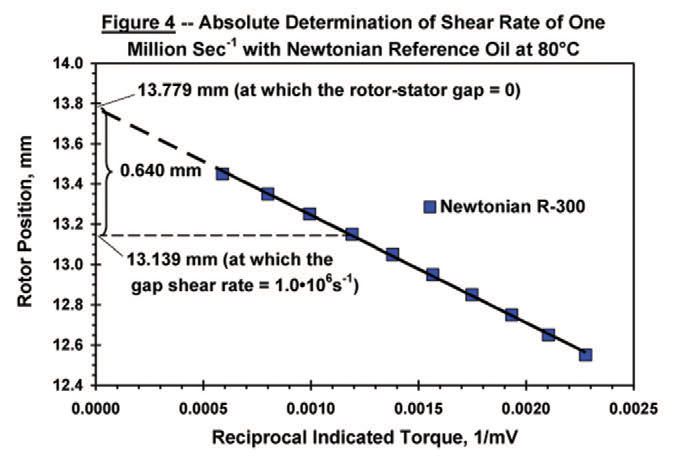 Figure 4.
Figure 4.
Direct Determination of Shear Rate – Certified Newtonian oil such as R-300 (
4) is used to determine the rotor position at which the theoretically indicated rotor-stator gap is zero. This data permits the determination of the rotor position to obtain a gap yielding, in this case, one million reciprocal seconds shear rate at the chosen rotor speed. This determined rotor position can then be used to maintain that shear rate.
Indirect Determination of Shear Rate – Another approach is to use a certified non-Newtonian fluid blended to have the same value of viscosity as the Newtonian fluid at a known shear rate as shown in
Figure 5. When the Newtonian and non-Newtonian certified reference oils give the same torque values by rotor adjustment, the rotor position is at the certified shear rate.
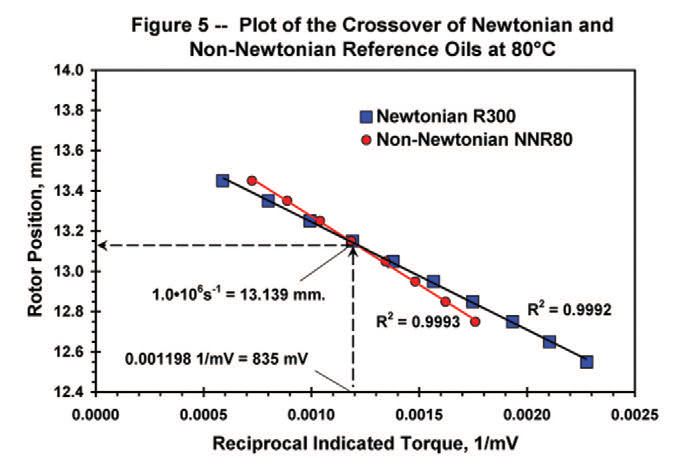 Figure 5.
Maintenance of Correct Shear Rate
Figure 5.
Maintenance of Correct Shear Rate – The data generated by this technique can be used to maintain the Tapered Bearing Simulator viscometer at precisely the desired shear rate during operation. This is done without operator intervention by the fully automated TBS shown in
Figure 3.
Discussion
Growing Value of High Shear Rate Viscometry – Engine design is advancing rapidly with great emphasis on durability, performance and fuel efficiency. With those objectives, the contribution of the engine oil and its formulation to these goals has similarly increased markedly. As always, there is the need for understanding the best balance between the immediate benefits of fuel efficiency and engine longevity.
Of the properties that formulation imparts to the engine oil, viscosity is perhaps the most critical physical property. This leads immediately to the importance of proper viscometry.
With the shear-rate dependence of the obviously popular Multi-Grade oils, high shear rate viscometers that will provide accurate viscosities are necessary to meet the high shear rate standards set by the SAE J300 Engine Oil Classification System for the viscous performance of all engine oils.
Studies of Multi-Grade Oils on the Market – As previously noted, the fact that Multi-Grade engine oils are subject to both TVL and PVL, makes high shear rate viscosity measurements indispensible. Furthermore, although such viscosity loss has a negative effect on engine wear protection, it may be considered to have a positive effect on fuel efficiency where lower viscosities reduce viscous friction in the engine.
Overall Viscosity Loss –With the growing importance of engine durability, performance and fuel efficiency, knowing and understanding Multi-Grade viscosity loss is even more important today. Both temporary and permanent viscosity losses contribute independently to the overall viscosity loss (OVL) of a Multi-Grade engine oil.
The magnitude of such viscosity loss is reported among the massive accumulation of viscometric values among the other technical data in the Engine Oil Database published by the Institute of Materials (
5) on hundreds of engine oils collected yearly from markets around the world.
Figure 6 shows a comparison of the OVL of engine oils collected from markets in North America in recent years.
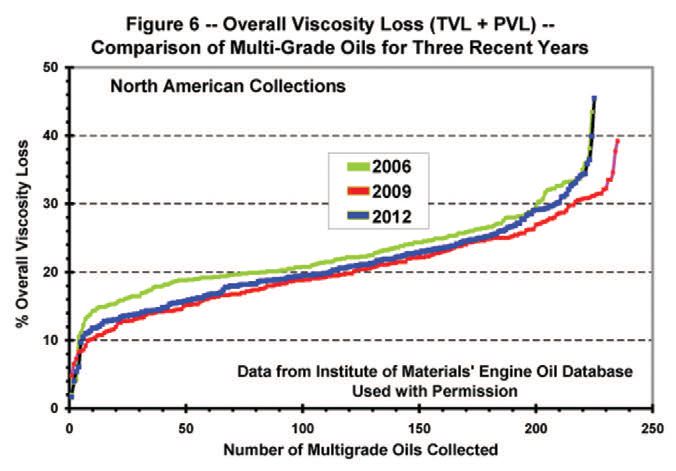 Figure 6.
Figure 6.
It is evident in
Figure 6 that the trends in OVL for North American oils shown by the Engine Oil Database for these three years in this area of the world are very similar. The information clearly shows that it remains a matter of high interest to the manufacturers of engines and engine oils to closely follow the high shear rate properties of formulated engine oils. This pattern will become more interesting as the new lower viscosity engine oils enter the market.
New Lower Viscosity Grade Multi-Grade Oils –The need for high shear rate information is even more important with the recent trend toward lowerviscosity, Multi-Grade engine oils that have led to a change in the SAE J300 Viscosity Classification for the first time in a number of years. This change is from the previous lowest Grade of SAE 20 (which has a high shear rate viscosity minimum of 2.6 centiPoise at 150°C and one million 1/sec. shear rate) to a Grade of SAE 16 having a minimum viscosity of 2.3 centiPoise under the same analytical conditions.
The obvious benefit for those engines made to operate with SAE 16 oils is a significant improvement in fuel efficiency. Manufacturers of other and previous engines are studying the viscosity/wear issues closely, however, since inadvertent use of such lower viscosity oil may adversely affect such engines.
High Shear Rate Viscometry and Fuel Efficiency – It has been estimated that viscosity of the engine oil may be responsible for 70% or more of the engine’s frictional losses of energy. The impact of TVL and PVL and the ability of the TBS viscometer to accurately determine these values led to a technique for estimating the fuel efficiency associated with these viscosity losses (
6). This study resulted in the Fuel Efficiency Index (FEI) in which lower values indicate higher fuel efficiency.
Figure 7 shows the Fuel Efficiency Indices of the oils of
Figure 6.
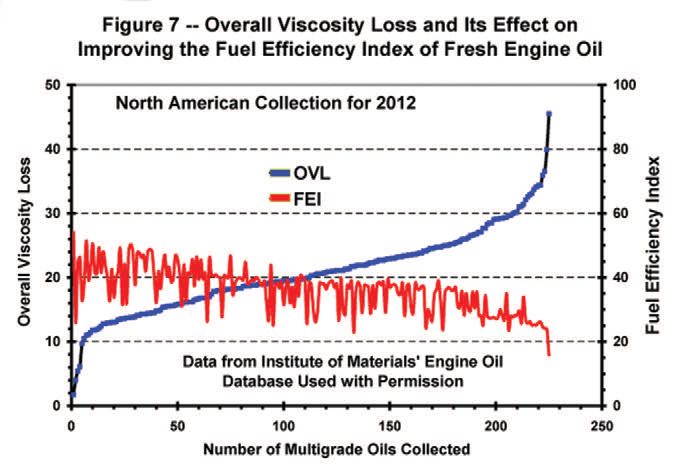 Figure 7.
Figure 7.
It is evident from the general decrease (improvement) in FEI accompanying the increase in OVL that the latter has significant effect on the former. It is also interesting to note the vertical variation of FEI in the data reflecting the influence of formulation in choice of base-stocks and soluble polymers. These data are expected to change significantly as lower viscosity Multi-Grade oils enter the market.
Summary
High-shear-rate viscometry and the viscometers that are claimed to provide such data call for care and understanding of such viscometers and the assumptions under which they are operated.
The precision and accuracy and even the validity of these data are highly dependent on such understanding. Assumption of shear rate without proof, temperature control, and freedom from confusing TVL and PVL are obvious cautions.
With the growing desire for lower viscosity Multi-Grade engine oils and the need to determine non-Newtonian response at lower engine operating temperatures, freedom from erroneous assumptions regarding high shear rate viscometry is even more important.
References
1.
F. Girshick, “Non-Newtonian Flow Dynamics in High Temperature High Shear Capillary Viscometers”, SAE Paper 922288, 1992.
2.
T.W. Selby and D.A. Piasecki, “Development and Performance of the Tapered Bearing Simulator for High Shear, High Temperature Viscometry”, Proceedings of the 1982 International Conference on the Viscometry of Automotive Lubricants, pp. 37-47, 1982.
3.
T.W. Selby and D.A. Piasecki, “The Tapered Bearing Simulator – An Absolute Viscometer”, SAE Paper 83031, SAE International Congress & Exposition, Detroit, Michigan, February 28 – March 4, 1983
4.
Newtonian and non-Newtonian reference oils are available from the Tannas Company, 4800 James Savage Rd., Midland, Michigan 48642, U.S.A. Telephone #: 1-989-496-2309 , E-mail address:
tannas@savantgroup.com
5.
Institute of Materials,
www.instituteofmaterials.com
6.
T.W. Selby, “The Viscosity-Dependent Fuel Efficient Index for Engine Oils”, 16th International Colloquium Tribology, Technische Akademie Esslingen, Stuttgart, Ostfildern, Germany, January 15–17. 2002